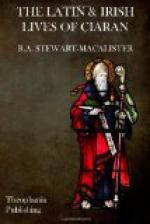Iarcain is a word of uncertain meaning: it probably denotes the waste stuff left behind in the vat.
IX. HOW CIARAN RESTORED A CALF WHICH A WOLF HAD DEVOURED (LA, LB, LC, VG)
Parallels.—Practically the same story is told of Abban (VSH, i, 24; CS, 508) and of Colman (CS, 828). A similar story is told of Saint Patrick (LL, 91), but it is not quite identical, inasmuch as here the wolf voluntarily restored a sheep which it had carried off. Something like this, however, is indicated in the Latin verse rendering of the story (No. 2 of the Latin verse fragments at the end of LB). More nearly parallel is the tale of Brigit (LL, 1250; CS, 19) who gave bacon which she was cooking to a hungry dog; it was miraculously replaced. A converse of this miracle is to be found in the Life of Ailbe, who first restored two horses killed by lions, and then miraculously provided a hundred horses for the lions to devour (CS, 239). Aed gave eight wethers to as many starving wolves, and they were miraculously restored to save him from the indignation of his maternal aunt (VSH, ii, 296). It is obvious, but hypercritical, to complain that in these artless tales the kindness shown to the beasts is illogically one-sided!
The Process of Resuscitation.—The important point in the tale, though the versions do not all recognise this, is the collection of the bones of the calf. VG preserves the essential command to the wolf not to break these. Colum Cille reconstituted an ox from its bones (LL, 1055). Coemgen gave away to wayfarers the dinner prepared for the monastic harvestmen, and when the latter naturally protested, he collected the bones and re-clothed them with flesh, at the same time turning water to wine (VSH, i, 238). Aed performed a similar miracle in the nunnery at Clonmacnois, replacing Ciaran’s dinner which he himself had eaten (VSH, i, 39). There is here no mention of the bones, but very likely this has become lost in the process of transmission. By all these tales we are reminded of the boar Saehrimnir, on whose flesh the blessed ones in Valhalla feast daily—sodden every evening and reconstituted from its bones every morning.[13] In a Breton folk-tale, La princesse Troiol, the hero has been burnt by the wiles of his enemy, but his sorceress fiancee seeks among the ashes till at last she finds a tiny splinter of bone. With this she is able to restore her betrothed; without it she would have been powerless.[14]
Very probably the practice of “secondary interment” of human bones, which we find so far back as the later stages of the Palaeolithic age, is based upon the same belief; that if the bones are preserved, their owner has a chance of a fresh lease of life.
There is a curious variant of the story in the Life of Coemgen. Here the cow is driven home, and Coemgen, called upon to soothe its lamentations, fetches, not the bones of the eaten calf, but the culprit wolf, which comes and plays the part of the calf to the satisfaction of all concerned (VSH, i, 239). It is evident that in this case there is another element of belief indicated: the personality of the calf has passed into the wolf which has devoured it—in fact, the wolf is the calf re-incarnate.




